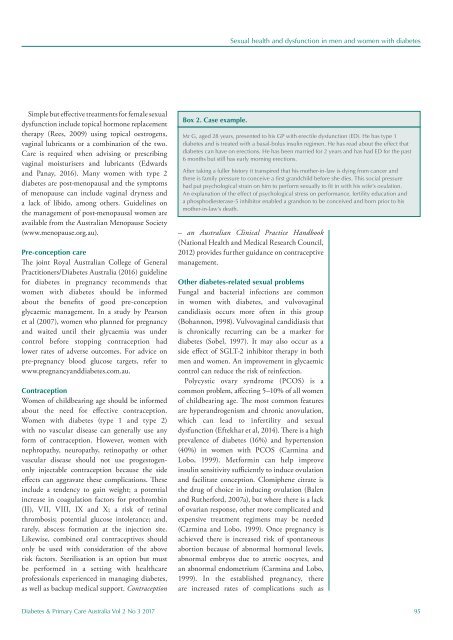DPCA 2-3_entire_v3
You also want an ePaper? Increase the reach of your titles
YUMPU automatically turns print PDFs into web optimized ePapers that Google loves.
Sexual health and dysfunction in men and women with diabetes<br />
Simple but effective treatments for female sexual<br />
dysfunction include topical hormone replacement<br />
therapy (Rees, 2009) using topical oestrogens,<br />
vaginal lubricants or a combination of the two.<br />
Care is required when advising or prescribing<br />
vaginal moisturisers and lubricants (Edwards<br />
and Panay, 2016). Many women with type 2<br />
diabetes are post-menopausal and the symptoms<br />
of menopause can include vaginal dryness and<br />
a lack of libido, among others. Guidelines on<br />
the management of post-menopausal women are<br />
available from the Australian Menopause Society<br />
(www.menopause.org.au).<br />
Pre-conception care<br />
The joint Royal Australian College of General<br />
Practitioners/Diabetes Australia (2016) guideline<br />
for diabetes in pregnancy recommends that<br />
women with diabetes should be informed<br />
about the benefits of good pre-conception<br />
glycaemic management. In a study by Pearson<br />
et al (2007), women who planned for pregnancy<br />
and waited until their glycaemia was under<br />
control before stopping contraception had<br />
lower rates of adverse outcomes. For advice on<br />
pre-pregnancy blood glucose targets, refer to<br />
www.pregnancyanddiabetes.com.au.<br />
Contraception<br />
Women of childbearing age should be informed<br />
about the need for effective contraception.<br />
Women with diabetes (type 1 and type 2)<br />
with no vascular disease can generally use any<br />
form of contraception. However, women with<br />
nephropathy, neuropathy, retinopathy or other<br />
vascular disease should not use progestogenonly<br />
injectable contraception because the side<br />
effects can aggravate these complications. These<br />
include a tendency to gain weight; a potential<br />
increase in coagulation factors for prothrombin<br />
(II), VII, VIII, IX and X; a risk of retinal<br />
thrombosis; potential glucose intolerance; and,<br />
rarely, abscess formation at the injection site.<br />
Likewise, combined oral contraceptives should<br />
only be used with consideration of the above<br />
risk factors. Sterilisation is an option but must<br />
be performed in a setting with healthcare<br />
professionals experienced in managing diabetes,<br />
as well as backup medical support. Contraception<br />
Box 2. Case example.<br />
Mr G, aged 28 years, presented to his GP with erectile dysfunction (ED). He has type 1<br />
diabetes and is treated with a basal-bolus insulin regimen. He has read about the effect that<br />
diabetes can have on erections. He has been married for 2 years and has had ED for the past<br />
6 months but still has early morning erections.<br />
After taking a fuller history it transpired that his mother-in-law is dying from cancer and<br />
there is family pressure to conceive a first grandchild before she dies. This social pressure<br />
had put psychological strain on him to perform sexually to fit in with his wife’s ovulation.<br />
An explanation of the effect of psychological stress on performance, fertility education and<br />
a phosphodiesterase-5 inhibitor enabled a grandson to be conceived and born prior to his<br />
mother-in-law’s death.<br />
– an Australian Clinical Practice Handbook<br />
(National Health and Medical Research Council,<br />
2012) provides further guidance on contraceptive<br />
management.<br />
Other diabetes-related sexual problems<br />
Fungal and bacterial infections are common<br />
in women with diabetes, and vulvovaginal<br />
candidiasis occurs more often in this group<br />
(Bohannon, 1998). Vulvovaginal candidiasis that<br />
is chronically recurring can be a marker for<br />
diabetes (Sobel, 1997). It may also occur as a<br />
side effect of SGLT-2 inhibitor therapy in both<br />
men and women. An improvement in glycaemic<br />
control can reduce the risk of reinfection.<br />
Polycystic ovary syndrome (PCOS) is a<br />
common problem, affecting 5–10% of all women<br />
of childbearing age. The most common features<br />
are hyperandrogenism and chronic anovulation,<br />
which can lead to infertility and sexual<br />
dysfunction (Eftekhar et al, 2014). There is a high<br />
prevalence of diabetes (16%) and hypertension<br />
(40%) in women with PCOS (Carmina and<br />
Lobo, 1999). Metformin can help improve<br />
insulin sensitivity sufficiently to induce ovulation<br />
and facilitate conception. Clomiphene citrate is<br />
the drug of choice in inducing ovulation (Balen<br />
and Rutherford, 2007a), but where there is a lack<br />
of ovarian response, other more complicated and<br />
expensive treatment regimens may be needed<br />
(Carmina and Lobo, 1999). Once pregnancy is<br />
achieved there is increased risk of spontaneous<br />
abortion because of abnormal hormonal levels,<br />
abnormal embryos due to atretic oocytes, and<br />
an abnormal endometrium (Carmina and Lobo,<br />
1999). In the established pregnancy, there<br />
are increased rates of complications such as<br />
Diabetes & Primary Care Australia Vol 2 No 3 2017 95
















